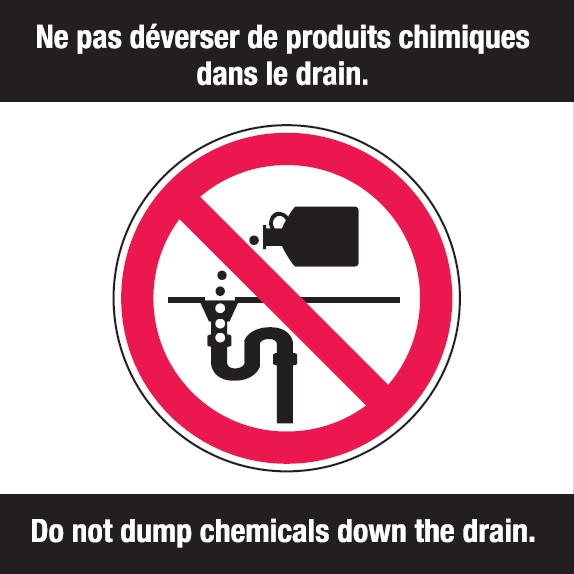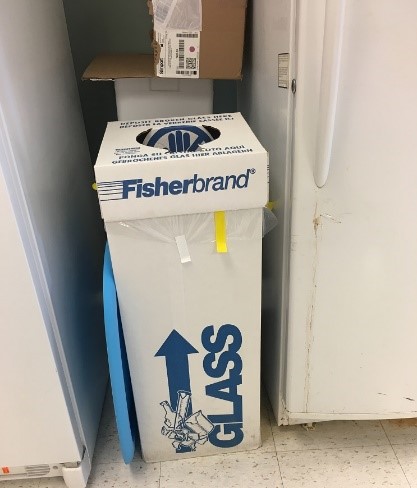There are five types of biomedical waste: biological material, laboratory‑associated, anatomical (human and animal), blood and bodily fluids, and mixed waste. Non-pathogenic (non‑Risk Group 2, 3 or 4 biological agents) waste may be incorporated into the biomedical waste stream as deemed appropriate by the Office of the Chief Risk Officer. In general, Containment Level 1 laboratories should handle their waste as non-hazardous (except if it contains needles or chemical or radiation hazards), going directly to the regular waste route through garbage bags. If a Level 1 lab still wishes to autoclave their waste before disposing of it, or if their waste is genetically modified material or non-native, which requires autoclaving as per Environment Canada regulations, they must label the bag as non-pathogenic material. In the absence of a secure or appropriate way to dispose of a non-pathogenic material, please contact the Office of the Chief Risk Officer to discuss the appropriate disposal route.
The procedure for biological waste disposal (PDF, 798KB) is available from the Office of the Chief Risk Officer.
Module 6.6 - Radiological
There are four main waste streams:
- Radioactive Waste Held for Decay (solid or liquid)
- Liquid Scintillation Waste
- Liquid Aqueous Waste
- Radioactive Material Requiring Off‐site Disposal
The fifth waste stream is Radioactive Carcass Waste, which overlaps with Biomedical Waste Procedures and Animal Care and Veterinary Service Waste Procedures. See section 5 in the University of Ottawa Biomedical Waste Disposal Procedures.
Module 6.7 - Spills
In most cases, users working with hazardous materials can safely and efficiently clean up a spill. Users are required to know the hazardous properties of materials prior to using them and must be prepared for potential spills; as a result, users are the most qualified to address the spill. Users and laboratories are equipped with basic spill kits for minor spills (i.e., liquid spills of up to 4 L).
Users of more hazardous materials, such as mercury and hydrofluoric acid, require specialized spill kits. Spills of greater volume may require additional interventions, as well as larger kits.
For all hazardous material spills, determine if you can safely contain, control and clean the spill
- If unsure or if the situation is unsafe, call Protection Services at ext. 5411 or 613-562-5411. Do not activate the fire alarm unless there is a fire.
- If the chemical enters a floor or sink drain, immediately block the drain (if safe to do so) and contact Protection Services at ext. 5411 or 613-562-5411. Floor drains can be protected using the granulated absorbent material in the spill kit. Do not allow any hazardous materials (including hazardous waste) to enter lab sinks at any time.
- If hazardous vapours that could escape the local area are present, alert people in the affected area and contact Protection Services at ext. 5411 or 613-562-5411. When reporting a spill to Protection Services, provide your name, a contact phone number, and exact details of the spilled material, namely:
- Whether anyone has been injured or exposed
- Name of the spilled material (include its spelling) and/or the CAS number
- Phase of the material (liquid, solid, gas)
- Identifying properties (colour, odour, etc.)
- Location(s) of the spill and if it is spreading (to other rooms, through floors, etc.)
- Quantity or volume of spill
- Properties of the spilled material, including (if applicable/known):
- Lower and upper explosive limits
- Flash point
- Vapour pressure
- Concentration
- Associated hazards
- First aid measures taken for those exposed
The caller must remain available in a safe location in the event that Protection Services requires further information. While not recommended, if you must leave the spill scene for any reason, place signage to warn others of the nature of the spill: include your name, your direct telephone number and the time you will return.
Once the spill has been absorbed, place all clean‐up material (including disposable protective equipment) into a sealable, labelled container. The contents of this container will be considered hazardous waste, and you must apply a hazardous waste label to the container. The user must submit the Accident, Incident, Occupational Disease or Near Miss report form. Formal Spill Response Training is available from the Office of the Chief Risk Officer. For additional information, refer to the Hazardous Materials and Waste Management Procedure (PDF, 1.1MB) or contact the Office of the Chief Risk Officer.
General procedure for chemical spills
Alert all personnel present and evacuate/clear the room. Minimize spread of the spill to the extent possible. Do not remove contaminated material from the spill area. Close the door and post a warning sign that states your name, your direct telephone number, the date and time, and the following message: “no entry – chemical material spill.”
- Restrict access to the area to those involved in cleaning the spill.
- If flammable material is involved, remove all heat sources (including burners and hot plates).
- Quickly block or contain the size and spread of the spill by using appropriate absorbing material (such as sand, vermiculite, inert spill absorbents, spill pillows or berms).
- Ensure the fume hood sash (where applicable) is open to capture or direct the flow of gases and vapours.
- Ensure that all those who are cleaning the spill are wearing appropriate personal protective equipment, which may include respiratory protection, gloves, protective eyewear and clothing.
- Clean the spill from its outer perimeter and deal with obstacles (such as broken glass and physical objects) as you clean toward the centre. Use forceps or tongs to handle broken materials. A final surface decontamination may be required in order to neutralize any remaining contaminated surface.
- Once the spill has been absorbed, place all clean‐up material (including disposable protective equipment) into a sealable, labelled container. The contents will be handled as hazardous waste. Apply a hazardous waste label to the container.
- Inform the principal investigator responsible for the lab/research project.
- Complete an Accident, Incident, Occupational Disease or Near Miss Report and a Hazardous Materials Technical Services Regular Collection Request.
- Remain available, in a safe location, to answer questions if further information is required.
Spills of hazard-specific materials (such as mercury or hydrofluoric acid) may require varied spill cleaning procedures. Please consult the Laboratory Safety Manual.



